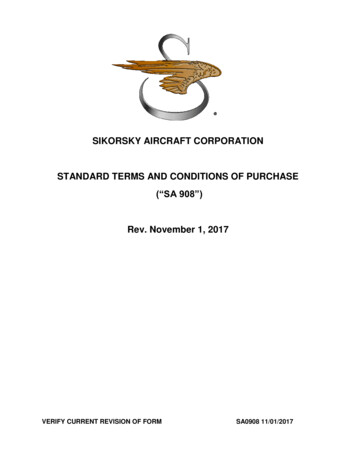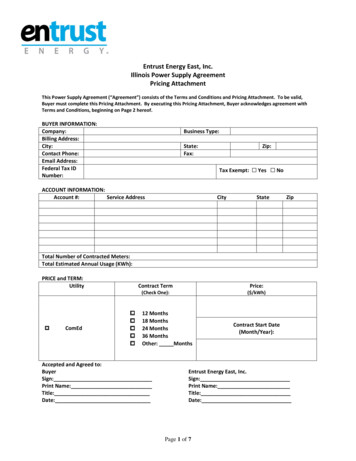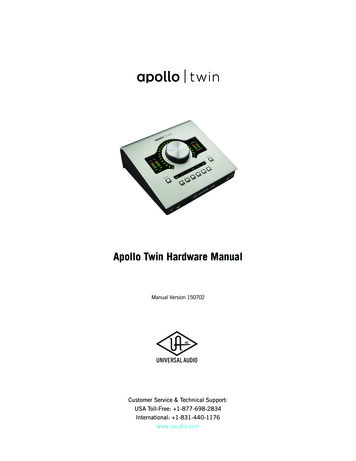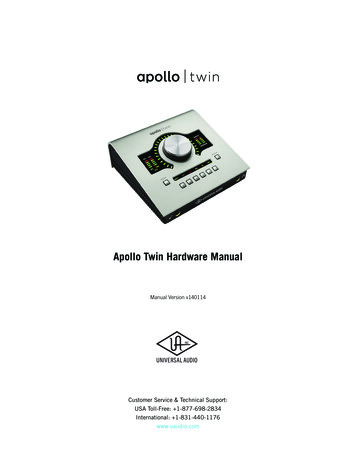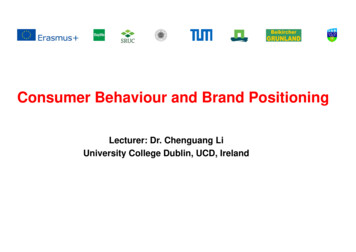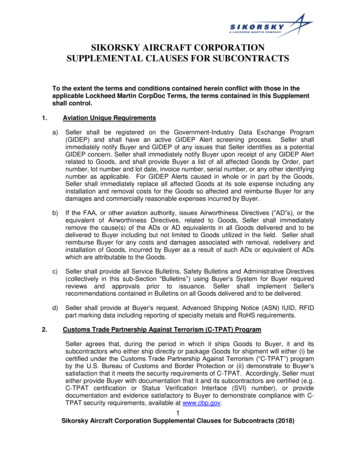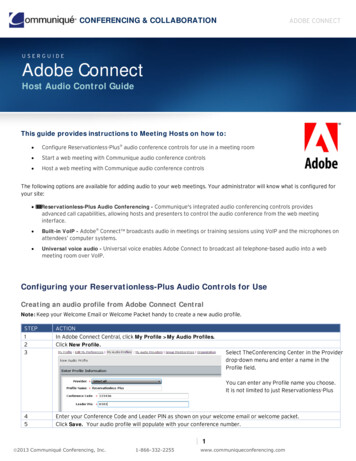
Transcription
A Digital Audio Buyer’s GuideAn overview and resource for planning and buying digital audio advertisingA PRI L 2015 2015 Interactive Advertising Bureau
This document has been developed by theIAB’s Digital Audio Committee.Special thanks to the following for their help in drafting this paper: Doug Sterne of Pandora, MikeAgovino of PodcastOne (formerly Triton Digital), Les Hollander of Spotify, Mitchell Halfen of CBSInteractive, Rick Ducey of BIA/Kelsey, Benjamin Masse and Mike Reznick of Triton Digital, Bret Kinsellaand Ian Bates of XAPPmedia, David Kert of TargetSpot, Elias Roman and Cheryl Jasper of Songza/Google Play, Rockie Thomas of Adswizz, and Todd Goldberg of iHeartMedia. The development ofthis paper was led by Luke Luckett, Projectize Media, acting as a consultant for the IAB.About the IAB Digital Audio CommitteeThe IAB’s Digital Audio Committee aims to establish industry guidance by creating standards andbest practices that bring clarity to the Digital Audio marketplace. The Committee strives to educatemarketers and agencies on the value of Digital Audio as a powerful and effective advertising medium.Committee Co-Chairs: Doug Sterne, Pandora and Mike Agovino, PodcastOne (formerly Triton Digital)IAB Digital Audio Committee MembersAbacastESPN.comABC RadioExtreme ReachABC TV NetworkFlurryActive InternationalGoogleAdLarge MediaiHeartMediaAdswizzLibsynADTECHMidroll MediaAlliance for Audited MediaNational Public Media(AAM)New York Public RadioAOLNielsenBIA/KelseyNTENTBidtellectPandoraCBS InteractivePGA TOURCBS LocalPixalateCMG DigitalPodcastOnecomScorePodtracDisney InteractivePROXi DigitalErnst & YoungPubMaticRAIN EnterprisesRawVoiceRUNSales Athlete Media NetworkSAS InstituteSlateSpotifyTargetSpotThe Center For Sales StrategyTime Inc.Triton DigitalTuneInUnivision CommunicationsWebspectatorWestwood OneWorldNowXAPPmediaAbout the IABThe Interactive Advertising Bureau (IAB) empowers the media and marketing industries to thrive inthe digital economy. It is comprised of more than 650 leading media and technology companiesthat are responsible for selling, delivering, and optimizing digital advertising or marketing programs.Together, they account for 86 percent of online advertising in the United States. Working with itsmember companies, the IAB evaluates and recommends standards and practices and fields criticalresearch on interactive advertising. The organization is committed to professional development,elevating the knowledge, skills, and expertise of individuals across the digital marketing industry. TheIAB also educates marketers, agencies, media companies and the wider business community aboutthe value of interactive advertising. Founded in 1996, the IAB is headquartered in New York City.IAB Contact InformationCarl Kalapesi, VP, Industry Initiatives212.380.4731carl@iab.netA DIG ITA L AU DIO BU Y E R ’ S GUI D E1
Table of ContentsIntroduction . . . . . . . . . . . . . . . . . . . . . . . . . . . . . . . . . . . . . . . . . . . . . . . . . . . . . . . . . . . . . . . . . . . . . .3Terminology: What do we mean by “Digital Audio”? . . . . . . . . . . . . . . . . . . . . . . . . . . . . . . . . . . . .4Digital Audio’s Market Opportunity . . . . . . . . . . . . . . . . . . . . . . . . . . . . . . . . . . . . . . . . . . . . . . . . . . .4Large Audience Reach . . . . . . . . . . . . . . . . . . . . . . . . . . . . . . . . . . . . . . . . . . . . . . . . . . . . . . . . . . . . . . .4Shift in Audio Time Spent Listening . . . . . . . . . . . . . . . . . . . . . . . . . . . . . . . . . . . . . . . . . . . . . . . . . . . .5Easy Access to Mobile Consumers . . . . . . . . . . . . . . . . . . . . . . . . . . . . . . . . . . . . . . . . . . . . . . .7Favorable Demographics of Digital Audio . . . . . . . . . . . . . . . . . . . . . . . . . . . . . . . . . . . . . . . . . . . . .8Fully Measurable Impressions and Engagement . . . . . . . . . . . . . . . . . . . . . . . . . . . . . . . . . . . . . . . .9Monetization and Platforms . . . . . . . . . . . . . . . . . . . . . . . . . . . . . . . . . . . . . . . . . . . . . . . . . . . . . . . . .9Technically, What is Digital Audio? . . . . . . . . . . . . . . . . . . . . . . . . . . . . . . . . . . . . . . . . . . . . . . . . . . .9Types of Listener Consumption . . . . . . . . . . . . . . . . . . . . . . . . . . . . . . . . . . . . . . . . . . . . . . . . . . . . . . . 10Online Listening . . . . . . . . . . . . . . . . . . . . . . . . . . . . . . . . . . . . . . . . . . . . . . . . . . . . . . . . . . . . . . . . . . . . . 10Audio On-Demand / Podcasts . . . . . . . . . . . . . . . . . . . . . . . . . . . . . . . . . . . . . . . . . . . . . . . . . . . . . . . . 10Ad Types . . . . . . . . . . . . . . . . . . . . . . . . . . . . . . . . . . . . . . . . . . . . . . . . . . . . . . . . . . . . . . . . . . . . . . . . . . . . 12Ad Tracking Capabilities . . . . . . . . . . . . . . . . . . . . . . . . . . . . . . . . . . . . . . . . . . . . . . . . . . . . . . . . . . . . . 12Mobile and In-car listening . . . . . . . . . . . . . . . . . . . . . . . . . . . . . . . . . . . . . . . . . . . . . . . . . . . . . . . . . . . 12Audio Advertising Creative Best Practices . . . . . . . . . . . . . . . . . . . . . . . . . . . . . . . . . . . . . . . . . . . . . . 14IAB Creative Best Practices for Digital Audio Ads . . . . . . . . . . . . . . . . . . . . . . . . . . . . . . . . . . . . . . . . 15Digital Audio Ad Samples . . . . . . . . . . . . . . . . . . . . . . . . . . . . . . . . . . . . . . . . . . . . . . . . . . . . . . . . . . . 15Mobile and companion banners . . . . . . . . . . . . . . . . . . . . . . . . . . . . . . . . . . . . . . . . . . . . . . . . . . . . . . 16Native Audio – Visual Examples . . . . . . . . . . . . . . . . . . . . . . . . . . . . . . . . . . . . . . . . . . . . . . . . . . . . . . 17Mobile “go to” voice activated ad example . . . . . . . . . . . . . . . . . . . . . . . . . . . . . . . . . . . . . . . . . . . . 18Planning and Buying . . . . . . . . . . . . . . . . . . . . . . . . . . . . . . . . . . . . . . . . . . . . . . . . . . . . . . . . . . . . . . . 18Inventory Scale . . . . . . . . . . . . . . . . . . . . . . . . . . . . . . . . . . . . . . . . . . . . . . . . . . . . . . . . . . . . . . . . . . . . . . 18Entities . . . . . . . . . . . . . . . . . . . . . . . . . . . . . . . . . . . . . . . . . . . . . . . . . . . . . . . . . . . . . . . . . . . . . . . . . . . . . . 19Capabilities . . . . . . . . . . . . . . . . . . . . . . . . . . . . . . . . . . . . . . . . . . . . . . . . . . . . . . . . . . . . . . . . . . . . . . . . . 19“Keep in Mind” . . . . . . . . . . . . . . . . . . . . . . . . . . . . . . . . . . . . . . . . . . . . . . . . . . . . . . . . . . . . . . . . . . . . . . 20Success Metrics . . . . . . . . . . . . . . . . . . . . . . . . . . . . . . . . . . . . . . . . . . . . . . . . . . . . . . . . . . . . . . . . . . . 20Campaign Delivery . . . . . . . . . . . . . . . . . . . . . . . . . . . . . . . . . . . . . . . . . . . . . . . . . . . . . . . . . . . . . . . . . . 20How Does DAAST Work? . . . . . . . . . . . . . . . . . . . . . . . . . . . . . . . . . . . . . . . . . . . . . . . . . . . . . . . . . . . 21Delivery and DAAST . . . . . . . . . . . . . . . . . . . . . . . . . . . . . . . . . . . . . . . . . . . . . . . . . . . . . . . . . . . . . . . . . 22Verification . . . . . . . . . . . . . . . . . . . . . . . . . . . . . . . . . . . . . . . . . . . . . . . . . . . . . . . . . . . . . . . . . . . . . . . . . . 22Conversion & Attribution . . . . . . . . . . . . . . . . . . . . . . . . . . . . . . . . . . . . . . . . . . . . . . . . . . . . . . . . . . . . . 22Closing and the Future: What’s on the Horizon for Digital Audio? . . . . . . . . . . . . . . . . . . . . . . . . . . 23ADDENDUM . . . . . . . . . . . . . . . . . . . . . . . . . . . . . . . . . . . . . . . . . . . . . . . . . . . . . . . . . . . . . . . . . . . . . . 24References . . . . . . . . . . . . . . . . . . . . . . . . . . . . . . . . . . . . . . . . . . . . . . . . . . . . . . . . . . . . . . . . . . . . . . . 24Common Digital Audio Advertising Terms . . . . . . . . . . . . . . . . . . . . . . . . . . . . . . . . . . . . . . . . . . . . . . 25A DIG ITA L AU DIO BU Y E R ’ S GUI D E2
IntroductionAs babies, listening is one of the first activities we engage in. Our mother’s voice, our father’slaugh, and the sounds of the world for the first time ground us in familiarity, informing our emotionsand binding them to what we interpret through sight and touch. For most of us, audio builds thesoundtrack to our lives.The world of audio – news and entertainment, music and talk – has changed dramatically in the past15 years. Shifts in the music industry have changed the way artists and labels produce and promotemusic. Advancing technologies have broken many cost barriers, allowing anyone with tools andtalent to produce and distribute original content. Accessible data aids content producers in creativechoices, formats and delivery. And the consumer, who demands access to content on any deviceat any time, has inspired a revitalized audio experience that’s increasingly personal, impactful andon-the-go.Brand marketers have long understood the power of audio to connect with audiences. Whether it’smusic, news, sports, political talk or just the comfort of a friendly voice, audio retains its relevancetoday by taking advantage of digital delivery to give far greater choice, control and customization tothe listener. The result is a highly personal and exclusive advertising experience that creates a naturalopportunity for brand alignment.The unprecedented speed with which connected mobile devices have proliferated over the lastfew years is having a profound impact on consumer consumption of audio content. Radio hasprimarily been a “mobile” medium given its dominant historical in-car usage. Digital audio’s mobileascendency began by adding new listening contexts. With the advent of “earbuds”, consumers weregiven the freedom to listen during an array of activities traditionally void of audio companionship.The growth trajectory has increased as historical audio contexts, like in-office and at-home, havebeen disrupted by simple to use and more personalized experiences delivered through a broadvariety of devices and distribution channels, all with far less advertisements. Most recently, digitalaudio has gained traction as an in-vehicle choice and consumers are finding connected technologyas a key pricing differentiator in the automobile market. Simply put, in-car access leads to significantbehavior change.The digital audio market represents the least cluttered space in mobile advertising, while providingdeep targeting capabilities that are equivalent to other ad units. Exclusively available within an audiocontent experience, digital audio ads are native, above the fold and rarely avoided by consumers.For marketers, digital audio provides a necessary, unique, highly measurable and accountablecomponent of the media mix. It is a channel that offers reach in scale on its own when targetingmillennials or reaching broader demographics when in combination with legacy audio choices.A DIG ITA L AU DIO BU Y E R ’ S GUI D E3
The demand for digital audio is growing, and research supports this. Edison Research and TritonDigital’s Infinite Dial 2015 study showed that an estimated 115 million Americans listened to onlineradio and streamed audio content in the last week – a 22% increase over the prior year!The IAB and the members of its Digital Audio Committee have pursued a goal of educating marketers and agencies about audio advertising opportunities, and discussing best practices andguidelines for reducing operational costs while driving sector growth. With this Buyer’s Guide, theCommittee aims to answer questions that creatives, planners and buyers may have about investmentin digital audio advertising.Terminology: What do we mean by “Digital Audio”?An initial question often posed is, “what is digital audio?” It’s a great question, because digitalaudio covers a broad and dynamic array of services offered to consumers.For the purposes of this report, “digital audio” refers to partially or entirely advertising-supportedaudio programming available to consumers and delivered via the wired or mobile Internet. Thisdefinition covers a wide range of service: Broadcast AM/FM radio stations online; Purely online radio stations; Streamed audio content, with selections influenced by consumer input (which may also beavailable offline); Audio on-demand programs (commonly referred to as podcasts), which are downloaded toa device for later listening (which may be accessible via the publisher, third parties, or acrossmultiple platforms)There is no consistency on the terminology used in the industry to describe digital audio or itscomponent parts. Throughout this paper, the term “digital audio” will be used as per the definitionabove, however in certain cases, the studies and sources we’ve referenced utilize alternate terms,such as “internet audio” or “digital radio”. In the case of specific quotes and figures, the originalverbiage has been maintained as much as possible.Digital Audio’s Market OpportunityThe Digital Audio market is growing rapidly. Advertisers have recognized this and moved into thismarket for five key reasons: Large Audience Reach Positive Shift in Audio Time Spent Listening Easy Access to Mobile Consumers Favorable Demographics Full Measurability of Impressions and EngagementLarge Audience ReachMore than 50% of the U.S. population is now accessing digital audio each month. In past years, themain story about digital audio was its rapid growth. The growth is still there, but the bigger story foradvertisers is that sizeable audiences are now reachable. eMarketer reported in 2015 that DigitalRadio listening had reached more than 169 million people in the United States each month.A DIG ITA L AU DIO BU Y E R ’ S GUI D E4
US Monthly Digital Radio Listeners, 2013–2019millions and % 72018191.6148.811.5%20138.3%20146.1%2015MONTHLY DIGITAL RADIO LISTENERS3.7%2019% CHANGENote: internet users of any age who have listened to digital broadcasts of terrestrial radio stations, digital-onlyradio stations or audio podcasts via any device at least once per monthSource: eMarketer, Feb 2015Despite the inconsistency in terminology, research points to the same conclusion: digital audio isgrowing. With continued growth, the monthly audience for Digital Radio is expected to exceed 190million by 2019 - a 19.6% increase over 2014. According to Edison Research and Triton Digital,in 2015, 72% of consumers in the 18-34 age group listen to online radio each month, and 67%of the 18-49 age group listen to online radio each month. Advertisers need consumer reach andinterested in aligning their brand with music and spoken entertainment because of their outsizedposition in popular culture. In the past, broadcast radio was the only channel available to achievethis objective. Today, Digital Audio provides access to large audiences and the ability to coordinatemarketing with music tastes and spoken word niches even more closely.Shift in Audio Time Spent ListeningNot only are more people listening to Digital Audio, they are also listening for longer periods. Areview of Triton’s Top 20 Ranker of Digital Audio (2014) showed a weighted average session lengthof around 38 minutes, which is about four times longer than traditional radio listening sessions. Thisincreased consumption creates additional time and space for brands to sponsor audio content that’sconsumed based on moods and emotions.There are several studies that show the time spent listening to digital audio is increasing. EdisonResearch and Triton Digital in the 2015 Infinite Dial revealed that Internet radio listeners hadincreased weekly listening time at a 13.5% compound annual growth rate between 2008 and 2014.A DIG ITA L AU DIO BU Y E R ’ S GUI D E5
Average time ‘Weekly Online Radio Listeners’ spend listening to Online 3133 millionpeople43 millionpeople44 millionpeople57 millionpeople76 millionpeople87 millionpeople95 millionpeople119 e Radio Listening to AM/FM radio stations online and/or listening to streamed audio content availableonly on the internetBase: Weekly Online Radio ListenersSource: the 2015 Infinite Dial by Edison Research and Triton DigitalThat is the trend for the most active listeners. For more casual monthly listeners the growth rate iseven higher. eMarketer reported on an AccuStream Research report that indicated the past fiveyears have delivered a 47% compound annual growth rate in listening time across all listeners atseveral leading services.US Average Monthly Digital Music Listening Hours, 2009 – 2016billions of hours and % 3.001.3341.0%29.0%23.0%0.6120092010BILLIONS OF HOURS201120122013201420152016% CHANGENote: includes Shoutcast and track play hours via Napster, Pandora and Rhapsody: includes ad-supported, mobileand subscriptionSource: AccuStream Research,”Streaming Radio, Curated Station and Track Playing Music: Listening Hours andRevenues Analytics 2013 – 2016,” Dec 5, 2013 via eMarketerWhere is this listening time coming from? Again, Edison Research provides some insight from its indepth customer interviews in 2013. As expected, a significant portion is displacing time previouslyspent consuming audio through traditional sources such as broadcast radio (44%) and personalmusic collections (30%). However, about a quarter of listeners (26%) suggested that Digital Audiowas “new time” indicating it represented an overall increase in audio consumption.A DIG ITA L AU DIO BU Y E R ’ S GUI D E6
Changes in ListeningMostly replacingyour CDs/MP3collection30%Mostly replacinglocal “over-the-air”AM/FM radio stations44%It’s new time; nottime taken fromradio or CDs/MP3s26%Edison Research 2013Source: Edison Research Streaming Audio Task Force, Summer 2013The takeaway for marketers is that consumer usage of Digital Audio is increasing at a rapid rate, it ischanging consumer listening habits and it is an important place for brands to have a presence.As an added note of interest, a recent study by comScore and Spotify found that 70% of streamingaudio listeners, and 49% of non-streaming audio listeners listen to music without engaging in anyother activity, indicating that streamers treat listening as an activity in and of itself.Easy Access to Mobile ConsumersAnother key opportunity for marketers is reaching mobile consumers. Time spent on mobile isincreasing each year and it has become a more important channel for consumer reach. When itcomes to a channel for mobile consumers, Streaming Radio comes out on top according to 2014research by comScore and Millennial Media.Share of Online Time Spent, by Device and Content Category% share of online time spent by online adults aged18 in the USDURING JANUARY al Streaming 1%22%21%19%TVTravelAuto5%8%12%B2BSMARTPHONESource: comScore/Millennial Media retrieved via MarketingCharts.comA DIG ITA L AU DIO BU Y E R ’ S GUI D E7
Mobile audio also has a distinct advantage over other media because it can easily be consumedwhile on-the-go. “Ultramobile activities” such as driving, walking, exercising and working don’tallow for visual advertising engagement. By contrast, digital audio complements these activities welland is an important opportunity for brands to engage consumers when they are not distracted bycompeting visual advertisements.In fact, Nielsen estimates that 79% of audio consumption takes place while people are engagedin activities where visual media cannot reach them. These experiences range from driving andexercising to working, playing games and doing household chores. Digital Audio is uniquelypositioned to reach mobile consumers.Portion of Time Spent with Music Each WeekLISTENINGIN THE CAR23%LISTENINGWHILE WORKING(HOME OR OFFICE)16%LISTENING WHILE DOINGCHORES AT HOMELISTENING WHILE DOINGOTHER ACTIVITIES ALONE(E.G., PLAYING VIDEO GAMES, READING,SURFING THE WEB)LISTENINGWHILE EXERCISING15%13%12%How to read: 23% of all weekly time spent listening to music happens in the car.Source: NielsenMany audio experiences are also automatically optimized for this increasing variety of mobilescenarios. A natural benefit of digital audio is that advertisers and content producers do not haveto worry about screen sizes or optimizing for different platforms; digital audio is a one-size-fits-alladvertising vehicle for mobile.Favorable Demographics of Digital AudioDigital Audio is used widely across age groups. However, it has particularly strong usage in thecoveted 18-34 age group where consumers are starting to make choices about brands that can lasta lifetime. The 2015 Infinite Dial by Edison Research and Triton Digital found that 72% of 18-34 yearolds listened to online radio monthly.A DIG ITA L AU DIO BU Y E R ’ S GUI D E8
Monthly Online Radio Listening(Age)72%67%53%Age 12 Age 18–34Age 18–49% listening to Online Radio in last monthOnline Radio Listening to AM/FM radio stations online and/or listening to streamed audio content available onlyon the internetSource: 2015 Infinite Dial by Edison Research and Triton DigitalIn fact, when you look at 12-24 year old voters, Edison data indicates that 75% use Internet Audiomonthly. Taken together these cohorts represent the 80 million millennial consumers that is the largestpopulation group in U.S. history. Although Digital Audio has shown particular strength amongyounger listeners, its reach is strong among all demographics including 21% of adults 55 and older.Fully Measurable Impressions and EngagementAdvertises have noted that Digital Audio’s ability to report actual audience impressions and adengagement is a plus. A Nielsen survey for the CMO Council in late 2014 showed that 95% ofmarketing executives would increase their digital brand spending if there were metrics to verify results.Because Digital Audio is a fully online medium, there is no guesswork or sampling required to estimatethe reach of a campaign. The data is all reported and can be verified by third party ad trackingservices. This can be an important element of campaigns where assured ad delivery is critical.In addition, the fully measurable aspect of Digital Audio also introduces demographic and behavioraltargeting opportunities. For marketers looking to achieve reach, frequency, engagement, targeting andmeasurability all in a mobile friendly package, Digital Audio presents a unique opportunity to supportadvertising campaigns.Monetization and PlatformsTechnically, What is Digital Audio?Digital audio is the storage, transmission and consumption of audio over IP, depending on hardwareand software to code and decode music or sound files. The use of metadata tagging allows the files tobe searchable based on editable parameters including, but not limited to, sound file content title, lengthand author. The two primary types of content associated with digital audio are music and spoken word.Distribution platforms include publisher owned and operated desktop and mobile apps, which includemusic services, AM/FM simulcasts, audio content aggregators, and on-demand and time-shiftedcontent like podcasts.Emerging digital audio consumption and delivery platforms include the connected car, standaloneconsumer electronic appliances, and Over-the-Top (OTT) and Internet Protocol Television (IPTV)technology.A DIG ITA L AU DIO BU Y E R ’ S GUI D E9
Digital Audio available on tablets, desktops, and mobile.Types of Listener ConsumptionOnline ListeningDigital Audio services offer a variety of ways through which listeners can consume audio content.Music and other audio services may include connected experiences around entertainment properties(i.e. TV shows), news, comedy, personalities, and the like.A unicast is a playlist-driven stream with skipping abilities. Interactive content selection allowslisteners to choose the piece of content to consume at any time and create custom playlists.Pureplay audio providers enable listeners to consume audio in a similar fashion to AM/FM radiostations, but do not own or operate a local AM/FM radio station and simulcast content in the sameinteractive, linear fashion.Simulcast live radio enables radio stations to deliver selected programs or entire channels over-theair and online.Audio On-Demand / PodcastsSince its inception in the early 2000s, Podcasting has grown from an Apple specific product podcasting to a cross platform digital audio product universally called audio on-demand. Whilenumbers are not publicly available, industry estimates suggest that iTunes maintains a 65 – 70%share of audio on-demand listenership. Other on-demand distribution platforms catering to both iOSand Android systems are also emerging.Podcasts/Audio On-Demand are downloadable, time-shifted content typically presented in anepisodic series and can be consumed offline. This cached/offline audio content enables the listenerto consume audio content which is downloaded or cached to their mobile device for offline listening.Fresh data for The Infinite Dial 2015 study shows 10% year over year growth for the percentage ofpeople indicating they had listened to a Podcast. This represents some 89 million people or a full1/3 of the population.A DIG ITA L AU DIO BU Y E R ’ S GUI D E10
APPROXIMATELY89 MILLIONPodcast 82009201020112012201320142015% ever listening to a podcastBase: Total Population 12 Source: the 2015 Infinite Dial by Edison Research and Triton DigitalApproximately 10% of the population or 27 million people are estimated to listen to Podcasts weeklyand those that do listen to an average of 6 Podcasts a week.Number of Podcasts Listened to in Last WeekSix to Ten9%11 or more15%One14%Four or Five17%Two22%Three23%Base: Weekly podcast listenersSource: the 2015 Infinite Dial by Edison Research and Triton DigitalA DIG ITA L AU DIO BU Y E R ’ S GUI D E11
Audio On-demand provides buyers a variety of unique audio advertising opportunities, including: Personality Endorsement or Native audio ads, live and pre-recorded Billboard and sponsorships of episodes and shows Custom content including specially created, personality driven on-demand episodes tailoredaround a product promoted directly from the brands website. Display and social ‘360’ advertising opportunities with synced display Dynamic 1 to 1 pre-roll and mid-roll audio ads with full targeting capabilities includinggeotargeting and ad tracking.At the time of publication, the IAB’s Podcast Working Group – a subset of the Digital AudioCommittee – has been working on a separate educational white paper about ad-supportedpodcasts and audio on-demand. Stay tuned to IAB.net or @iab on Twitter for alerts as to when thispaper will be released to industry.Ad TypesAdvertising in digital audio generally means inserting an audio ad into the stream of content.Linear audio ads typically demand full audible attention from the listener because the ad takes overthe audio experience entirely for a bounded duration of time. In some cases, publishers will offer aset of ad pods, which deliver a set of sequential linear ads, similar to what is found on BroadcastAM/FM and Broadcast TV scenarios.Digital audio ads can be delivered in a broadcast (one to many) or unicast (one to one) manner.Audio ads delivered in a broadcast manner follow content regardless of distribution platform. In thecase of unicast ads the distribution of content can be separated from delivery of the ads.Within digital audio, there are often opportunities that surround the player environment. It is alsocommon to find companion ads in the form of synced banner ads and/or synced video ads.See the “Digital Audio Ad Samples” on pages 15-18 of this guide, as well as expanded audio creativesamples online at www.iab.net/audiobuyersguide.Ad Tracking CapabilitiesGiven the nature of the environments in demand for audio content, audio player software and devicesalong with their capabilities play a big role in how ads are served and tracked in digital audio. Playerscan range from full-featured, such as a browser based player or device-native application, completewith visual components, to a limited, or “thin,” client such as a car stereo with only the ability to playan audio stream. Similar to other digital advertising mediums, most publishers are able to support thirdparty ad serving and tracking for digital audio streaming ads. Audio playback triggers the trackingpixels that are needed to report impressions and events by both the publisher and 3rd party ad serversbased on the listener’s activity, and within compliance with IAB measurement guidelines.Mobile and In-car listeningThe Connected Car market is drastically changing the way listeners experience audio offeringsbeyond the traditional AM/FM dial. The Infinite Dial 2015 report indicated a 50% increase forlistening to Online Radio in the car; such growth seems to be coming at the expense of both theCD Player and AM/FM Radio. As greater scale comes to the space via connected cars, rich newopportunities emerge for advertisers to target hyper-locally.A DIG ITA L AU DIO BU Y E R ’ S GUI D E12
Audio Sources Used in Primary Car84%86%81%AM/FM Radio63%61%CD Player55%29%31%MP3 Player/Owned Digital Music38%12%14%Online Radio21%20132014201515%17%17%Satellite Radio% currently ever using medium in the primary carBase: Each 18 and Driven/Ridden in car last monthSource: 2015 Infinite Dial Study. Edison Research and Triton Digital; Base:
in 2015, 72% of consumers in the 18-34 age group listen to online radio each month, and 67% of the 18-49 age group listen to online radio each month. Advertisers need consumer reach and interested in aligning their brand with music and spoken entertainme

